 |
 |
 |
 |
 |
 |
 |
 |
|
|
 |
 |
 |
Inpainting
 |
|
 |
|
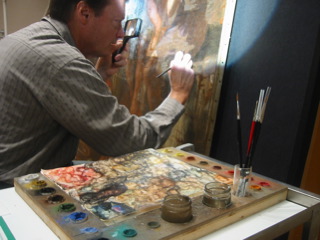
David begins the time consuming and exacting stage of inpainting the losses in the original paint layer. Staying within the borders of the actual losses, he uses paint made dry pigments ground in a stable, non-discoloring synthetic resin medium. The inpaint is applied with small sable brushes in thin, transparent layers. The surface gloss of the inpaint is adjusted by controlling the amount of synthetic medium that is mixed with the dry pigments.
|
|
 email a postcard of this entry email a postcard of this entry
|
 |
 |
 |
 |
|
|
 |
 |
 |
Tools of the Trade - Filling Losses
 |
|
 |
|
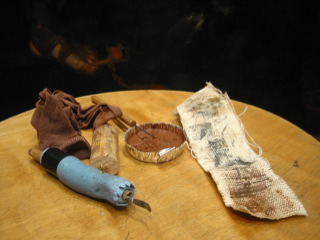
In the profession of art conservation, tools are most often adopted or adapted from other fields. Pictured here is a selection of tools and common objects used for filling losses or voids in the original paint layer.
Pigmented microcrystalline wax (the red-brown material in the tin) is applied into the loss with a small spatula (foreground on the left). This much-used tool is hand-made for this purpose.
The wine cork is sometimes utilized to level wax fills; the panty hose fabric is used to texture and buff the wax. Texture is imparted into the new wax fill with a variety of materials and techniques, including dental tools, bits of cloth, or a blunt needle.
|
|
 email a postcard of this entry email a postcard of this entry
|
 |
 |
 |
 |
|
|
 |
 |
 |
|
 |
|
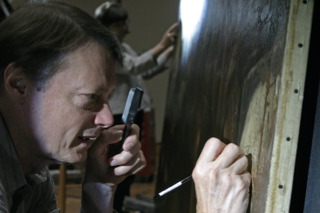
David is concentrating on the badly damaged lower right corner of the painting. Here he is carefully inpainting a portion of the sheep's wool. In the background, Joan is resurfacing an old fill to better match the texture of the surrounding original paint.
|
|
 email a postcard of this entry email a postcard of this entry
|
 |
 |
 |
 |
|
|
 |
 |
 |
|
 |
|
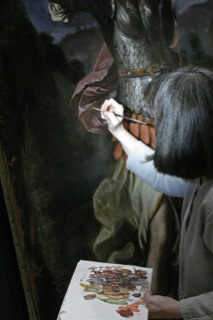
Working on the figure of Erminia at the left side of the composition, Joan inpaints a 4 inch loss in the paint in the purple drapery. The loss is very typical of a tear in the canvas or a deep scratch or scrape in the paint layer.
|
|
 email a postcard of this entry email a postcard of this entry
|
 |
 |
 |
 |
|
|
 |
 |
 |
Tools of the Trade - Inpainting
 |
|
 |
|
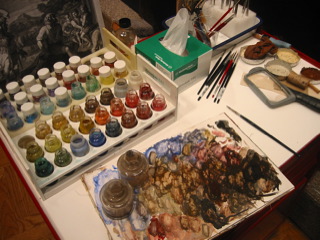
Inpainting losses and abrasion is accomplished with dry pigments brush-ground in a stable, non-discoloring synthetic medium. The thin, transparent layers of inpaint are applied to the losses with tiny watercolor brushes.
The conservators match colors by eye. In a complicated, large area of loss, scores of colors may be applied to create the allusion of 17th century paint. Inpaint is limited to within the boundries of the losses in the painting.
The use of modern dry pigments and a synthetic paint medium is intentional. The synthetic resin does not change chemically with aging, remaining soluble in very mild solvents. In addition, the new materials are easily detected by another conservation professional. Importantly, the new fill and inpainting are isolated from the original paint layer by a synthetic resin varnish.
|
|
 email a postcard of this entry email a postcard of this entry
|
 |
 |
 |
 |
|
|
 |
 |
